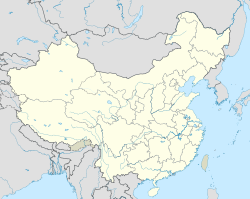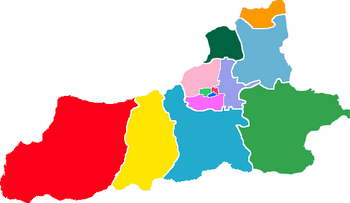Xi'an
Xi'an
西安 Chang'an · 長安 | |
|---|---|
西安市 | |
 From top: City wall of Xi'an, Xingqinggong Park, Drum Tower of Xi'an, Great Mosque of Xi'an, Southeast city corner, Giant Wild Goose Pagoda, Nan'erhuan Road | |
 Location of Xi'an City jurisdiction in Shaanxi | |
| Coordinates: 34°16′N 108°54′E / 34.267°N 108.900°E | |
| Country | People's Republic of China |
| Province | Shaanxi |
| Government | |
| • CPC Xi'an | Sun Qingyun (孙清云) |
| • Mayor | Dong Jun (董军) |
| Area | |
| • Sub-provincial city | 9,983 km2 (13.9 sq mi) |
| • Urban | 826 km2 (319 sq mi) |
| • Metro | 3,830 km2 (1,480 sq mi) |
| • Yangling | 94 km2 (36 sq mi) |
| Elevation | 405 m (1,329 ft) |
| Population (2010 census) | |
| • Sub-provincial city | 8,467,837 |
| • Density | 850/km2 (610,000/sq mi) |
| • Urban | 6,501,200 |
| • Urban density | 7,900/km2 (20,000/sq mi) |
| • Metro | 7,168,005 |
| Time zone | UTC+8 (CST) |
| Postal code | 710000 - 710090 |
| Area code | +86/29 |
| GDP | (2010) |
| - Total | ¥ 324.1 billion |
| - Per capita | ¥26,259 |
| License plate prefixes | 陕A |
| City flower | Pomegranate flower |
| City tree | Pagoda tree |
| Website | www |
Xi'an (Chinese: 西安 pinyin:Xī'ān) is the capital city of the Shaanxi Province in China. Its metropolitan area has a population of 6 million people in 2011.[1] This city is famous for the splendid Terracotta Army was found inside the tomb of Chinese first emperor Qin Shi Huang.[2]
History
[change | change source]In past China, it was the capital of 13 dynasties, including the Zhou Dynasty, the Qin Dynasty, the Han Dynasty, the Sui Dynasty, and the Tang Dynasty. It was the eastern end of the ancient Silk Road[3] and was commercial hub linked to home of silk production city Suzhou and Hangzhou. Xi'an is regarded as one of the most oldest capitals in the world history together with the other three Athens, Rome and Cairo.
Name
[change | change source]Xi'an was called Chang'an in ancient times. In Classical Chinese it literally means "Perpetual Peace". But from 9 AD-23 AD, during the Xin Dynasty, it was renamed "Constant Peace" (it is said the same way). By the time of the Ming Dynasty it had been named Xi'an (which means "Western Peace"). It was named Xi'an because was in the western part of the Ming Empire.
Political divisions
[change | change source]Xi'an Municipality is divided into 10 districts and 3 counties.
- Beilin District
- Yanta District
- Weiyang District
- Baqiao District
- Xincheng District
- Lianhu District
- Chang'an District
- Yanliang District
- Lintong District
- Gaoling District
- Lantian County
- Zhouzhi County
- Huyi District
Culture
[change | change source]Xian's profound culture is featured by many kind of traditional festivals, handicrafts and more ethnic flavor.
- Yango - Popular rural folk dance
- Qinqiang - Shaanxi local opera
- Shaanxi Shadow Play
- Fengxiang Clay Figurines
Tourism
[change | change source]As ancient capital, Xian's rich history is reflectey by the relic of Chinese dynasties such as ancient emperor story, imperial tombs, palace legends in the Qin, Han and Tang Dynasty. The following attractions is top among them.
- Banpo Neolithic Village
- Terracotta Army & Warriors
- Xian Ancient City Wall
- Bell & Drum tower
- Big Wild Goose Pagoda
- Hanyangling Mausoleum
- Xi'an
-
Terracotta Army
-
Ancient City Wall
-
Ancient City Wall
-
Big Wild Goose Pagoda
-
Big Wild Goose Pagoda
-
Mosque
-
Hanyangling Mausoleum
-
Market
-
Street food
References
[change | change source]- ↑ "About Xian -- Xian introdution, sightsiing, tour, tour package, hotel reservation, shopping and cuisine". www.sinohotelguide.com. Archived from the original on 2019-10-27. Retrieved 2008-06-11.
- ↑ "Xi'an Travel Guide, Terracotta Warriors China Shaanxi Tour Facts". Archived from the original on 2013-01-16. Retrieved 2013-03-08.
- ↑ "The Silk Road China Travel Maps, Tourist Map of Silk Road China, The Silk Road China". www.thesilkroadchina.com.











